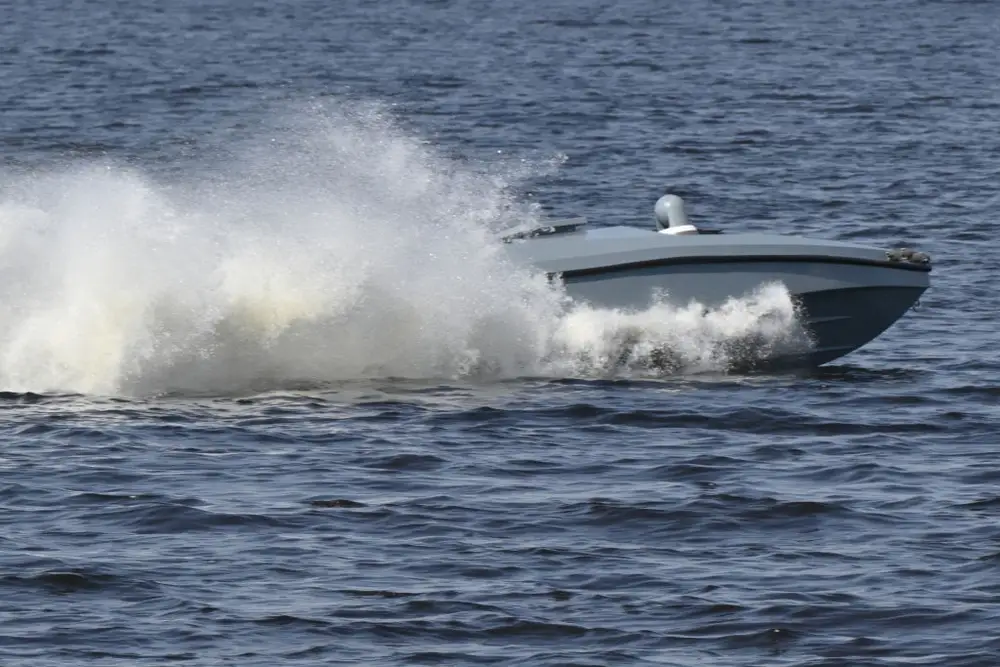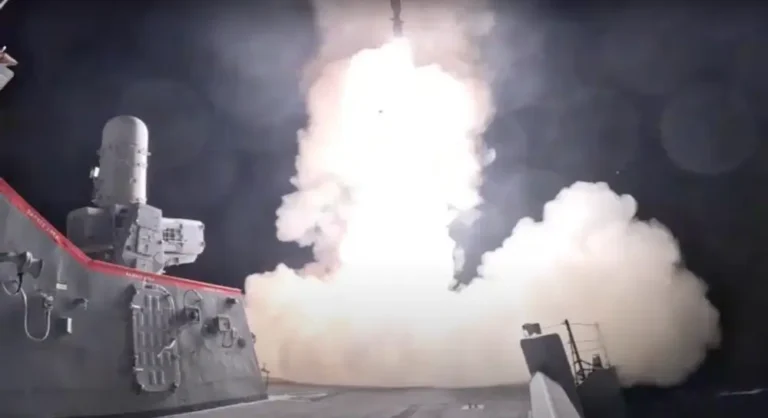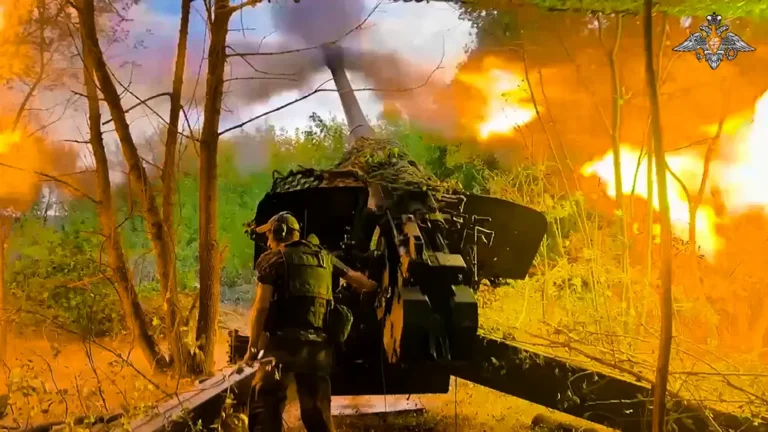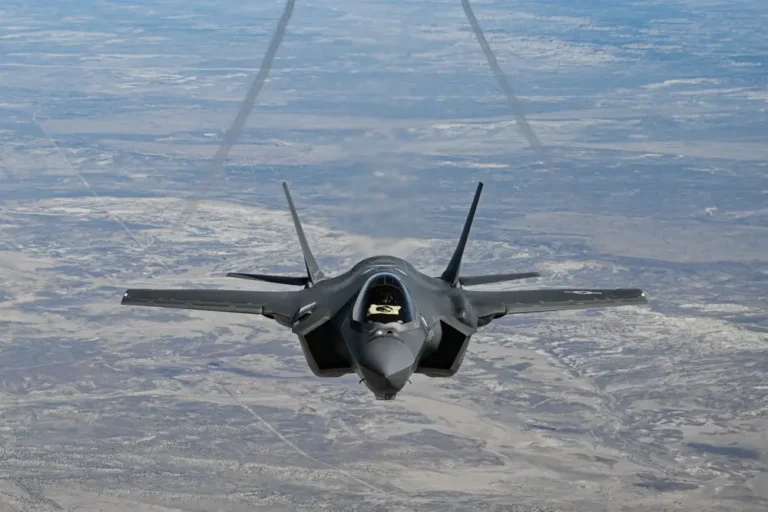Taiwan is one-upping Ukraine’s navy to defeat a Chinese invasion

Taiwan is developing naval drones similar to those used so effectively by Ukraine, like the Magura drone seen here.
Taking a cue from Ukraine’s use of naval drones to offset a superior Russian fleet, Taiwan has unveiled a much larger unmanned kamikaze boat that could devastate a Chinese amphibious force.
Taiwanese media describe a 20-ton robot vessel that’s 55-feet-long, 12-feet-wide, and with a draft of about 3 feet. “The vessel’s top speed exceeds 30 knots (55.56 km/h), and it can cover a range of over 300 miles (555.6 km) with a fuel capacity of 1,300 liters,” according to Taiwan’s Liberty Times newspaper. “What’s remarkable is its ability to navigate autonomously, even without GPS or communication equipment, thanks to its advanced onboard computer systems. Its potential military applications range from mine clearance and minesweeping to suicide missions.”
The unmanned surface vessel, or USV, was revealed June 2 while Taiwanese leaders attended the shipyard christening of a new frigate and other manned vessels. Photographs show a low, streamlined black boat with bright orange stripes.
The USV has been a “universal test platform,” and Taiwanese officials have not said whether this design will stay experimental or go into mass production to create a horde of robot explosive boats. But if not this one, Taiwan will certainly field some kind of unmanned attack boat to try to stop a Chinese invasion or blockade.
US officials have already spoken of a “hellscape” strategy that would use drones to turn the Taiwan Straits into a graveyard. Exactly what this entails is classified. But Adm. Samuel Paparo, chief of US Indo-Pacific Command, told a Washington Post reporter last month that “as soon as China’s invasion fleet begins moving across the 100-mile waterway that separates China and Taiwan, the US military would deploy thousands of unmanned submarines, unmanned surface ships and aerial drones to flood the area and give Taiwanese, US and partner forces time to mount a full response.”
“I want to turn the Taiwan Strait into an unmanned hellscape using a number of classified capabilities,” Paparo said. “So that I can make their lives utterly miserable for a month, which buys me the time for the rest of everything.”
The threat to attack a Chinese invasion force right away may not be achievable, however. In May, China’s military surrounded Taiwan and practiced attack drills, the kind of large-scale exercise that could become cover for a military operation like a beach assault.
Taiwan may have better luck in the water than in the air. Taiwan’s attempt to develop a medium-altitude, long-endurance drone — along the lines of the US MQ-9 Reaper — has run into developmental difficulties. The unmanned aircraft has yet to pass its combat readiness test, leading Taiwan to order more American-made MQ-9B SeaGuardians, a maritime version of the Reaper.
Both Taiwan and America are looking to what has become the gold standard in naval drone warfare: Ukraine’s campaign in the Black Sea. Vastly outnumbered and outgunned by Russia’s navy, and with a long coastline to defend, Ukraine could have been bled white trying to defend against Russian amphibious invasions and coastal bombardment.
Instead, Russia’s Black Sea Fleet has retreated from Ukrainian waters. In part this is because of land-based anti-ship missiles such as the Neptune, which sank the cruiser and Black Sea Fleet flagship Moskva in 2022. But mostly it’s because of robot boats that have relentlessly stalked Russian warships on the sea and even in port. In November 2023, for example, Ukrainian Magura sea drones sank or damaged two Russian landing craft and a missile corvette docked in Crimean ports and shipyards.
The Magura appears to be much smaller than the Taiwanese USV, at about 18 feet long. It weighs about a ton, can carry a 400-pound warhead, and had a range of 500 miles, with batteries sufficient for 60 hours of operation.
This is a classic case of asymmetric warfare: though vastly outnumbered in conventional military resources, Ukraine turned to cheap alternatives that could be manufactured by its own domestic arms industry and exploited the enemy fleet’s vulnerability.
Taiwan faces a similar dilemma. With a population of just 24 million compared to China’s 1.4 billion, and vastly less resources and manufacturing capacity, Taiwan probably can’t prevail in a straight-up naval battle with Chinese naval, air and missile forces, not even with the help of allies Japan and the US.
But it doesn’t have to win. It can succeed by showing China that a battle for Taiwan is simply too bloody and fraught with risk. Taiwan would need to sink or damage enough transport vessels that near the island to make a beach landing or blockade untenable. With insufficient troops, heavy weapons and supplies ashore, the beachhead would be vulnerable to being swept into the sea by a Taiwanese counterattack.
Similarly, enough kamikaze drones could force China’s large fleet farther off-shore in hopes of creating openings for air drops of supplies from Taiwan’s allies. Even then, China may have the sheer fleet size to strangle Taiwan.
This shows that drones will be an essential and low-cost way to stave off China.






